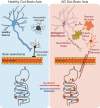Gut Microbiota: From the Forgotten Organ to a Potential Key Player in the Pathology of Alzheimer's Disease
- PMID: 31738402
- PMCID: PMC7302187
- DOI: 10.1093/gerona/glz262
Gut Microbiota: From the Forgotten Organ to a Potential Key Player in the Pathology of Alzheimer's Disease
Abstract
More than 300 years ago, Antony van Leewenhoeck first described observing single-celled microorganisms, which he termed "animalcules," examining his saliva under a microscope. Although the idea of the coexistence of microorganisms in our body is not new, we have only recently been able to investigate their ecological relationship to our body, with the development of high-throughput molecular techniques. The diverse microorganism communities residing in our guts are established and maintained by complex interactions among microorganisms and their host. Notably, their alteration has been implicated in influencing various diseases including neurological diseases. Alzheimer's disease (AD) is the most common cause of dementia characterized by a progressive decline in memory and thinking severe enough to interfere with daily life. Despite the great progress in linking genetic risk factors with AD pathogenesis, treatments targeted at AD pathology and its modifiers have not yet resulted in a disease-modifying therapy. There is mounting evidence that the gut microbiota interacts with AD pathogenesis by disrupting neuroinflammation and metabolic homeostasis-the gut microbiota has gone from being the forgotten organ to a potential key player in the AD pathology.
Keywords: Amyloid; Bacteria; Microbiome; Neurodegeneration; Tau.
© The Gerontological Society of America 2019.
Figures


References
-
- Ley RE, Peterson DA, Gordon JI. Ecological and evolutionary forces shaping microbial diversity in the human intestine. Cell. 2006;124:837–848. doi: 10.1016/j.cell.2006.02.017 - PubMed
-
- Waters CM, Bassler BL. Quorum sensing: cell-to-cell communication in bacteria. Annu Rev Cell Dev Biol. 2005;21:319–346. doi: 10.1146/annurev.cellbio.21.012704.131001 - PubMed
Publication types
MeSH terms
LinkOut - more resources
Full Text Sources
Medical

